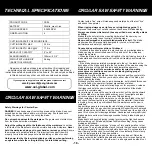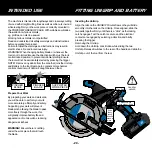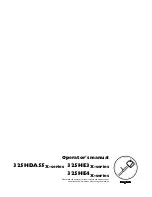
ASSEMBLE A TABLE SAW
Fit the Circular Saw to the
Case Lid
Open the case lid and
remove any fitted tools.
Fit the Blade Shield as
shown. Slide the Locking
Slider out of the way. Fit
the nose of the Sole Plate
into the recess on the left of
the large slot in the lid and
the blade through the slot.
Rotate the saw into place
and release the Locking
Slider, ensure it slides back
to hold the saw in place
securely.
Fit the Internal Power Coupling
onto the Rails on the saw in
where the POWERhandle
connects for handheld use.
Set Blade Depth and Blade
Angle then close and latch the
lid.
Fit the Rip Fence by hooking
the Small Hock onto the edge of
the case then place it flat on the
surface and rotate the large end
so the 2nd hock is over the edge
of the case, press the Sliding
Lock downward to lock into
place. To remove, slide this up
again and unhook the post.
The Protractor can slide in the
slots on either side of the saw.
All measurements should
be taken from the saw blade
when accuracy is vital. Provide
adequate support to the rear and
sides of the sawtable for wide or
long workpieces
These instructions should be read in
conjunction with those for the specific
model of tool being fitted.
- 22 -
CARE AND ENVIRONMENT
General inspection
Regularly check that all the fixing screws are present and tight,
they may vibrate loose over time.
Keep the tool’s air vents unclogged and clean at all times.
Remove dust and dirt regularly.
Cleaning is best done with compressed air or a rag.
CAUTION
, Do not use cleaning agents to clean the plastic parts of
the tool. A mild detergent on a damp cloth is recommended. Water
must never come into contact with the tool.
After each use, carefully clean the tool with a brush or rag.
Clear any debris from around the battery mount, moving parts and
clips.
Lubrication
No internal lubrication is necessary, the bearing area is sealed.
A coating of machine oil on the blade will help prevent corrosion
but must be cleaned off before cutting wood.
Storage
Store the tool, instruction manual and accessories in a secure, dry
place. In this way you will always have all the information and parts
ready to hand.
Lithium ion batteries should ideally be stored with 40 to 80%
capacity between 10ºC and 20ºC (50ºF and 68ºF). Other parts
should be stored between 10ºC and 24ºC (50ºF and 75ºF).
WARNING!
Always charge Li-ion batteries before storage and at
least every 3 months to prevent permanent damage.
Environment
When the time comes to dispose of this product please consider
the environment and take it to a recognised recycling facility
instead of disposing with general household waste.
Call your local council, civic amenity site, or recycling centre for
information on the recycling and disposal of electrical products and
batteries. If you do
not have access to suitable disposal facilities in your area please
contact your place of purchase, they will advise you on the best
way to dispose of your product.
Maintenance
All electrical parts should be regularly serviced by an approved
engineer.
























